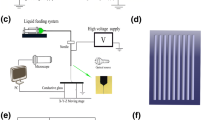Abstract
Electrospinning has become a popular polymer processing technique for application in vascular tissue engineering due to its unique capability to fabricate porous vascular grafts with fibrous morphology closely mimicking the natural extracellular matrix (ECMs). However, the inherently small pore sizes of electrospun vascular grafts often inhibit cell infiltration and impede vascular regeneration. Here we describe an effective and controllable method to increase the pore size of electrospun poly(ε-caprolactone) (PCL) vascular graft. With this method, composite grafts are prepared by turning on or off electrospraying of poly(ethylene oxide) (PEO) microparticles during the process of electrospinning PCL fibers. The PEO microparticles are used as a porogen agent and can be subsequently selectively removed to create a porogenic layer within the electrospun PCL grafts. Three types of porogenic PCL grafts were constructed using this method. The porogenic layer was either the inner layer, the middle one, or the outer one.
Access this chapter
Tax calculation will be finalised at checkout
Purchases are for personal use only
Similar content being viewed by others
References
Ekaputra AK, Prestwich GD, Cool SM et al (2008) Combining electrospun scaffolds with electrosprayed hydrogels leads to three-dimensional cellularization of hybrid constructs. Biomacromolecules 9(8):2097–2103
Xie Y, Guan Y, Kim SH et al (2016) The mechanical performance of weft-knitted/electrospun bilayer small diameter vascular prostheses. J Mech Behav Biomed 61:410–418
Wang W, Nie W, Zhou X et al (2018) Fabrication of heterogeneous porous bilayered nanofibrous vascular grafts by two-step phase separation technique. Acta Biomater 79:168–181
Guo Z, Grijpma DW, Poot AA et al (2017) Preparation and characterization of flexible and elastic porous tubular PTMC scaffolds for vascular tissue engineering. Polym Advan Technol 28(10):1239–1244
Zhu M, Wu Y, Li W et al (2018) Biodegradable and elastomeric vascular grafts enable vascular remodeling. Biomaterials 183:306–318
Muylaert DE, van Almen GC, Talacua H et al (2016) Early in-situ cellularization of a supramolecular vascular graft is modified by synthetic stromal cell-derived factor-1α derived peptides. Biomaterials 76:187–195
Wang K, Zheng W, Pan Y et al (2016) Three-layered PCL grafts promoted vascular regeneration in a rabbit carotid artery model. Macromol Biosci 16(4):608–618
Zhong S, Zhang Y, Lim CT et al (2012) Fabrication of large pores in electrospun nanofibrous scaffolds for cellular infiltration: a review. Tissue Eng Part B Rev 18(2):77–87
Zhao L, Ma S, Pan Y et al (2016) Functional modification of fibrous PCL scaffolds with fusion protein VEGF-HGFI enhanced cellularization and vascularization. Adv Healthc Mater 5(18):2376–2385
Leong MF, Rasheed MZ, Lim TC et al (2009) In vitro cell infiltration and in vivo cell infiltration and vascularization in a fibrous, highly porous poly(D,L-lactide) scaffold fabricated by cryogenic electrospinning technique. J Biomed Mater Res A 91A(1):232–240
Rnjak-Kovacina J, Weiss AS (2011) Increasing the pore size of electrospun scaffolds. Tissue Eng Part B Rev 17(5):365–372
Lowery JL, Datta N, Rutledge GC et al (2010) Effect of fiber diameter, pore size and seeding method on growth of human dermal fibroblasts in electrospun poly(ε-caprolactone) fibrous mats. Biomaterials 31(3):491–504
Blakeney BA, Tambralli A, Anderson JM et al (2011) Cell infiltration and growth in a low density, uncompressed three-dimensional electrospun nanofibrous scaffold. Biomaterials 32(6):1583–1590
McClure MJ, Wolfe PS, Simpson DG et al (2012) The use of air-flow impedance to control fiber deposition patterns during electrospinning. Biomaterials 33(3):771–779
Wright LD, Andric T, Freeman JW et al (2011) Utilizing NaCl to increase the porosity of electrospun materials. Mater Sci Eng C 31(1):30–36
Leong MF, Rasheed MZ, Lim TC et al (2009) In vitro cell infiltration and in vivo cell infiltration and vascularization in a fibrous, highly porous poly (D,L-lactide) scaffold fabricated by cryogenic electrospinning technique. J Biomed Mater Res Part A 91A(1):231–240
Baker BM, Gee AO, Metter RB et al (2008) The potential to improve cell infiltration in composite fiber-aligned electrospun scaffolds by the selective removal of sacrificial fibers. Biomaterials 29(15):2348–2358
Salata OV (2005) Tools of nanotechnology: electrospray. Curr Nanosci 1(1):25–33
Zhang S, Kawakami K (2010) One-step preparation of chitosan solid nanoparticles by electrospray deposition. Int J Pharm 397(1):211–217
Lee YH, Mei F, Bai MY et al (2010) Release profile characteristics of biodegradable-polymer-coated drug particles fabricated by dual-capillary electrospray. J Control Release 145(1):58–65
Almería B, Deng W, Fahmy TM et al (2010) Controlling the morphology of electrospray-generated PLGA microparticles for drug delivery. J Colloid Interf Sci 343(1):125–133
Wang K, Xu M, Zhu M et al (2013) Creation of macropores in electrospun silk fibroin scaffolds using sacrificial PEO-microparticles to enhance cellular infiltration. J Biomed Mater Res Part A 101(12):3474–3481
Zhu L, Wang K, Ma T et al (2017) Noncovalent bonding of RGD and YIGSR to an electrospun poly(ε-caprolactone) conduit through peptide self-assembly to synergistically promote sciatic nerve regeneration in rats. Adv Healthc Mater 6(8):1600860
Wang K, Zhu M, Li T et al (2014) Improvement of cell infiltration in electrospun polycaprolactone scaffolds for the construction of vascular grafts. J Biomed Nanotechnol 10(8):1588–1598
Zhong S, Zhang Y, Lim TC et al (2012) Fabrication of large pores in electrospun nanofibrous scaffolds for cellular infiltration: a review. Tissue Eng Part B Rev 18(2):77–87
Wang S, Zhang Y, Wang H et al (2009) Fabrication and properties of the electrospun polylactide/silk fibroin-gelatin composite tubular scaffold. Biomacromolecules 10(8):2240–2244
Acknowledgments
This work was supported by the National Natural Science Foundation of China (NSFC) projects (81772000, 81530059, 91939112), NSFC Research Fund for International Young Scientists (81850410552), and Tianjin Natural Science Foundation (18JCZDJC37600).
Author information
Authors and Affiliations
Corresponding author
Editor information
Editors and Affiliations
Rights and permissions
Copyright information
© 2022 The Author(s), under exclusive license to Springer Science+Business Media, LLC, part of Springer Nature
About this protocol
Cite this protocol
Rafique, M., Midgley, A.C., Wei, T., Wang, L., Kong, D., Wang, K. (2022). Controlling Pore Size of Electrospun Vascular Grafts by Electrospraying of Poly(Ethylene Oxide) Microparticles. In: Zhao, F., Leong, K.W. (eds) Vascular Tissue Engineering. Methods in Molecular Biology, vol 2375. Humana, New York, NY. https://doi.org/10.1007/978-1-0716-1708-3_13
Download citation
DOI: https://doi.org/10.1007/978-1-0716-1708-3_13
Published:
Publisher Name: Humana, New York, NY
Print ISBN: 978-1-0716-1707-6
Online ISBN: 978-1-0716-1708-3
eBook Packages: Springer Protocols




